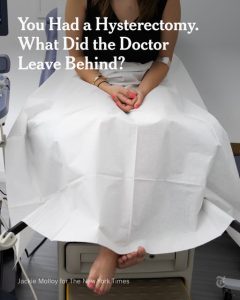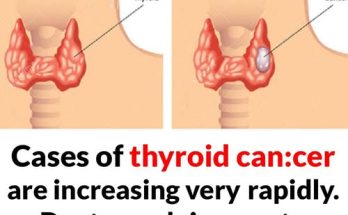
Patients often are in the dark about which organs remain and which were removed — particularly the ovaries, which profoundly influence lifelong health.
Stacia Alexander was 25 and pregnant when her OB-GYN first recommended a hysterectomy. It was 1996, and an ultrasound had revealed fibroids growing in the walls of her uterus.
But she knew what the procedure had done to her mother: After her ovaries and uterus were removed in her 40s, her mother faded into a sad, irritable shadow of herself.
So after giving birth, Dr. Alexander opted for surgery to prune back the fibroids. Years later, when the growths returned, she was again able to avoid a hysterectomy by choosing a uterine ablation, in which the lining of the uterus is burned away to prevent bleeding caused by fibroids.
But by the time she was 45, the fibroids were back, and her doctor informed her that she was “too old” for another uterus-sparing surgery.
Dr. Alexander, a psychotherapist in Dallas, was already on the operating table when a surgeon came in and asked whether she wanted a “full” or “partial” hysterectomy.
If she chose the second option, he warned, there would be no guarantee that she wouldn’t be back for another operation in two years. So Dr. Alexander agreed to a “full” hysterectomy.
The surgeon proceeded to remove her healthy ovaries, along with her uterus and fallopian tubes, according to her medical notes. Within months, she was in the throes of early menopause, which brought crippling anxiety, weight gain, arthritis in her fingers and “murderous” hot flashes.
“I felt like my body had deceived me, had abandoned me,” she said. “I didn’t know this new body.”
What the surgeon hadn’t told Dr. Alexander was that she could have avoided this fate by leaving intact her ovaries, the two powerful almond-size glands on either side of the uterus that pump out testosterone, estrogen, progesterone and other essential hormones.
“I did not know there was a way to separate it,” she said. “I thought a hysterectomy was a hysterectomy. I didn’t know I had another option.”

Hysterectomies have been steadily declining for decades, in part thanks to new, targeted treatments for fibroids and other sources of pelvic pain and bleeding.
But aside from C-sections, they are still the most common surgical procedure among women. Nearly 500,000 patients had a uterus removed in 2020. By the time they die, nearly half of women will have lost their uterus.
There are few procedures in which patients routinely go under the knife without understanding their full range of options — or leave the operating room not knowing exactly which of their organs remain. But that is exactly what happens to many hysterectomy patients today.
Dr. Emily Von Bargen, a urogynecologist at Massachusetts General Hospital, often sees women who have undergone a hysterectomy but don’t know exactly which of their organs were removed. “I would say 50 percent of patients don’t know the specifics around their surgery,” she said. “It really is mind-blowing.”
Much of the confusion boils down to two words often used to describe a hysterectomy: “total” and “partial.”
A total hysterectomy removes both the uterus and the cervix, the muscular doughnut at the base of the uterus. A partial, or supracervical, hysterectomy leaves the cervix in place. (A radical hysterectomy, a rarer procedure performed in cases of cancer, removes the uterus, cervix, surrounding tissue and sometimes the upper part of the vagina.)
The key distinction is this: a hysterectomy refers only to the uterus and cervix. Removal of the ovaries is a separate procedure, known as an oophorectomy. That means no matter what kind of hysterectomy you are getting, the ovaries may also be removed — or not.
Yet many patients still believe a total hysterectomy automatically includes ovarian removal, said Catherine, 78, a moderator of the hysterectomy support forum HysterSisters who asked to be identified by her first name to protect her privacy.
Therefore, they think a partial hysterectomy means the removal of the uterus and the cervix, but not of the ovaries or the fallopian tubes.
Adding to the confusion, some surgeons also use these terms incorrectly, said Dr. Von Bargen. “I always say, what does a hysterectomy mean to you?” she said. “Because to some people, a partial hysterectomy means keeping my ovaries.”
Dr. Cheryl Iglesia, a urogynecologist at MedStar Washington Hospital Center in Washington, D.C., said it was also common for women to believe they had undergone a total hysterectomy, only to learn later upon examination that they still had a cervix. This means they may still need regular Pap smears.
“Some people are shocked when you tell them,” she said. In addition, “they don’t necessarily always know what happened with the tubes or ovaries.”
A 2009 survey of women in Washington State who had undergone hysterectomies found that “a substantial proportion” believed they had one ovary removed, when in fact both were. Among more than 700 Norwegian patients who thought their ovaries had been removed, one-third actually still had ovaries, a 2024 survey found.
In 2019, a study in Michigan found that, even after consulting with a doctor, a “considerable proportion” of women undergoing hysterectomies did not understand which organs would be removed. Of 144 women who reported that they were having a partial hysterectomy, only 15 actually did; others actually had a total hysterectomy.
“That’s crazy, right?” said Dr. Zeinab Kassem, a fellow in maternal and fetal medicine at Tufts Medical Center and the lead author of the Michigan study. “You’re forced to speculate, why?”
One reason for the confusion, she said, could be that other common surgeries — gallbladder removal, hip replacement — typically involve a single, obvious body part. With reproductive organs, “you see them as all just one big organ, lumped together, with one purpose,” she said. “But the reality is, no, the ovaries serve a specific purpose on their own.”
Compartmentalized Thinking
Image

Historically, surgeons considered the uterus and the ovaries a package deal. The ovaries produced eggs and hormones that supported nearby reproductive organs; the uterus was where a fertilized egg implanted.
Both were thought of as essential for pregnancy, but expendable if a woman was done having, or did not intend to have, children.
“It was a compartmentalized way of thinking,” said Dr. Walter Rocca, a neurologist and epidemiologist at the Mayo Clinic who studies the consequences of ovarian removal. “The people concerned about reproduction, fertility and women’s health were not at the same time considering the possible effects on heart, bone, brain and other organs.”
By the 1990s, doctors were trained to remove the ovaries virtually any time they were taking out a uterus. “It was kind of the rule,” said Dr. Jonathan Berek, a gynecological oncologist who directs the Stanford Women’s Cancer Center. “When in doubt, take the ovaries out.”
The rationale was to prevent ovarian cancer, a silent killer. Before 2008, more than half of women who underwent a hysterectomy for reasons other than cancer had their ovaries removed as well.
“At a certain point in history, it seemed like everyone was just getting everything out for the most minor of indications,” said Dr. Karen Tang, a gynecologic surgeon outside Philadelphia. “They just didn’t realize how severe the health risks were.”
In the end, it was a layperson who challenged obstetrician-gynecologists to look at those risks more closely. Around 2000, Janine O’Leary Cobb, a Canadian women’s health activist who ran an early menopause newsletter, grew worried about the consequences of ovary removal.
Her readers had been writing in to describe severe menopause symptoms after the procedure. Research was scarce, but there were hints in the literature that removing the ovaries increased the risk of heart disease.
It did not take having a medical background to find this practice alarming, said Ms. O’Leary Cobb, now 91. “The human body evolved a certain way for certain reasons, and taking things out willy-nilly — it just doesn’t make sense that it would have no consequences,” she said.
She shared her concerns with Dr. William Parker, an OB-GYN and then clinical professor at the University of California, Los Angeles.
Dr. Parker had written a popular book on women’s health in which he suggested — conservatively, for the time — that women over 45 consider having their ovaries removed as “good prevention” for ovarian cancer.
Now he wondered if he had been right. Dr. Parker called up a former student who had trained in statistical analysis and assembled a team to find out.
Working without funding, the researchers developed a mathematical model that would weigh survival rates for women who kept their ovaries or had them removed, drawing on data from 200 published studies.
The results were sobering. Dr. Parker and his colleague found that ovarian cancer, while deadly, was also rare: A woman was 35 times more likely to die of cardiovascular disease, and about three times as likely to die of hip fracture. Both ailments were risks of early menopause, an unavoidable consequence of removing the ovaries.
The decision to remove ovaries as a cancer prevention measure “should be approached with great caution,” they concluded in an initial study in 2005.
Soon, Dr. Rocca and colleagues at the Mayo Clinic added to this evidence, linking the removal of the ovaries before menopause to a higher risk of cognitive decline and dementia.
Dr. Parker, however, was not finished. He realized he could compare the long-term health outcomes for thousands of women who had had hysterectomies with or without ovarian removal, using data from almost 30,000 women in the national Nurses’ Health Study who had been tracked for decades.
By 2009, the consequences were clear: Removing the ovaries was associated with an array of disease risks, including heart disease, osteoporosis, stroke, lung cancer, Parkinson’s disease and dementia. Those who lost their ovaries before menopause lived shorter lives and fared worse in almost every category compared with those who kept them. (Hormone therapy lowers some but not all of these risks.)
In fact, Dr. Parker’s 2005 model suggested that women could benefit from keeping their ovaries even after menopause, a finding supported by a secondary analysis of data from the Women’s Health Initiative. After menopause, the ovaries still produce androgens, some of which are converted into estrogen by fat and muscle and continue to confer a protective effect.
“This is a big deal,” Dr. Parker recalled thinking. “We’re talking about women’s ovaries that are taken out by the carload.” He himself had been performing at least one hysterectomy with oophorectomy per week.
Image

Removing Essential Organs
Seemingly overnight, the practice of removing healthy ovaries became “one of the most incredible controversies in the practice of gynecology,” in Dr. Rocca’s words.
Some doctors initially pushed back on the idea that they had been removing essential organs without good reason. Nevertheless, over the following decade, the hysterectomy was — quietly — decoupled from ovarian removal. In one county in Minnesota, Dr. Rocca and colleagues documented an 80 percent decline in the rate of oophorectomies among premenopausal women from 2005 to 2018.
No longer were the ovaries viewed as solely reproductive organs whose purpose was limited to pregnancy and childbirth. They were also batteries that powered the body’s health, contributing to skin elasticity, heart health, brain health and bone density.
In 2005, “when I started my residency, we were just like, Yeah, let’s take out the ovaries,” said Dr. Tang. By 2010, “we had pretty much stopped, cold turkey.”
These days, instead of the ovaries, surgeons performing a hysterectomy usually remove the fallopian tubes, where most ovarian cancer is believed to originate. Yet while even the American College of Obstetricians and Gynecologists now recommends that surgeons leave the ovaries intact, that standard has not been uniformly adopted.
In many regions of the United States, for example, hysterectomy rates are declining faster among white women than Black women. Compared with other groups, Black women and women in the South are the most likely to have had a hysterectomy, with or without ovarian removal.
The fact that Black women are more likely to have fibroids — the top reason for a hysterectomy — doesn’t fully explain this disparity, said Whitney R. Robinson, an associate professor of obstetrics and gynecology at Duke University School of Medicine who studies hysterectomy rates.
“There’s not a clear sense, is this being delivered at the appropriate rate in an equitable manner?” she said. Practice also varies by surgeon, and some of these professionals trained long before the ovarian paradigm changed.
Dr. Alexander, who is Black, said that she wished she had known the risks of having her ovaries removed and that she had been given a true choice in the matter.
After her surgery, her doctor offered to insert estrogen pellets under her skin, which she declined; she didn’t want to take a medication she couldn’t control herself. It would be three years before she found a women’s health clinic and was prescribed testosterone shots and a daily progesterone and estrogen pill.
The difference was immediate: Soon she felt her cognitive fog lift, her sex drive return and her arthritis improve.
The experience has made her especially protective of her 25-year-old daughter, Taylor, who was diagnosed with uterine fibroids last year. Because of their size, Taylor was told she would have to undergo an open abdominal surgery, similar to a C-section. No doctor has suggested a hysterectomy, yet.
Image

Just as the ovaries have been reconceptualized as endocrine organs that affect far reaches of the body, the uterus, too, may play a key role in overall health beyond childbearing, said Dr. Elizabeth Stewart, an OB-GYN at the Mayo Clinic.
As a result, true hysterectomies — those limited to removing only the uterus — may still be performed too liberally. “Even among health care providers, there is still a perception that as long as you leave the ovaries, hysterectomy is a no-risk solution,” she said.
Removing the uterus is known to cause temporary hot flashes, night sweats and other menopausal symptoms, probably because the procedure severs a blood vessel that connects this organ with the ovaries.
Women with hysterectomies also experience menopause on average four years earlier and are at greater risk for mental health conditions, cardiovascular diseases and obesity, for reasons not fully understood.
For Dr. Stewart, this raises an important question: Beyond its connection to the ovaries, is there some intrinsic, unstudied quality of the uterus that confers overall health benefits?
Her hunch is that the uterus, too, is an endocrine organ in its own right. During pregnancy and labor, it is known to produce hormones such as prolactin and prostaglandins.
“But does it play that role during the reproductive years?” Dr. Stewart wonders. “And even more importantly, does it play that role in post-reproductive years?”
Funding to pursue such questions is scarce, compared with that for heart disease and cancer research.
But, Dr. Stewart cautioned, “if you don’t think it’s an important question to ask, then you’re going to be astounded by the data 20 years later” — just as gynecologists were astounded by the consequences of ovarian removal.
Rachel E. Gross is the author of “Vagina Obscura: An Anatomical Voyage.”
An earlier version of this article misidentified Dr. William Parker’s current job. He is a volunteer clinical professor at the University of California, San Diego. He is no longer at the University of California, Los Angeles. In addition, the article misstated the year in which Dr. Karen Tang began her residency. It was 2005, not 2007.



